Adani Foists Coal Mines and Hinduism on Communities
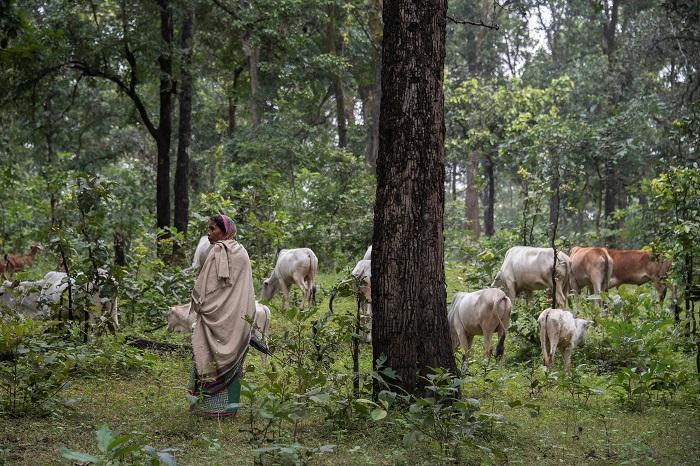
Indigenous people of Hasdeo Forest. | Photo: Brian Cassady
As a resource-rich state, Chhattisgarh in central India is the site of frequent conflict between people and mining corporations. In the Hasdeo Aranya forests, the indigenous Gond people face the obliteration of their way of life as the Adani Group pushes for a barrage of new coal mines. The large open-cut excavations pose obvious threats to forests, streams and ancestral lands. More subtle is the erosion of culture and religion by this corporate agenda, with local people complaining that Hinduism is being foisted on communities with their own unique religious beliefs.
The election to the provincial government of the Indian National Congress party in 2018 gave people hope that these incursions could be avoided. When in opposition, the Congress had often castigated the previous government for alleged irregularities, accusing it of supporting the interests of corporations over the interests of the people. It has now been nearly a year and a half that the Congress has been in power. How committed has it been to its positions taken before assuming power? Is the clout of the Adani group able to force the Congress to renege on its previous commitments? And what have been the responses of communities fighting to save their livelihoods and traditions?
In February 2020, I visited the Hasdeo Aranya forests to report on the situation for AdaniWatch and NewsClick.
The Adivasi Struggle
When I arrive at the Madanpur office of the Committee for the Struggle to Save the Hasdeo Forest, posters for candidates in local elections are pasted all over the walls. Its members had contested the local elections. The office – actually a small house – is the second as we enter the village off the nearby highway which, for the most part, curves around the Hasdeo Aranya forest. For a stretch of a few kilometres before and after Madanpur, the highway passes through the forest itself, an area that the local indigenous people are committed to protecting.
Why does this forest need saving? It is one of the largest contiguous tracts of dense forest in central India, covering 170,000 hectares and part of an elephant corridor that stretches across central India. It is a traditional home of Adivasi communities – India’s indigenous peoples. It is also the catchment area for the Hasdeo River – a major tributary of the Mahanadi, a significant river in central-eastern India. However, the forest also lies over an estimated five billion tonnes of coal.
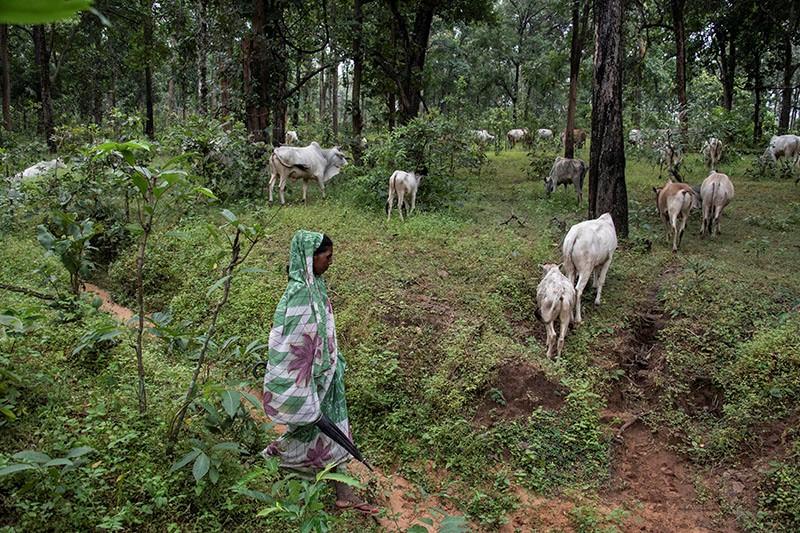
Adivasi people graze their livestock in the Hasdeo forests - on top of billions of tonnes of coal. Photo Brian Cassey
Thirty coal ‘blocks’ have been identified in the Hasdeo Aranya forest by the Indian government, and it should come as no surprise that India’s biggest private player in the coal industry – the Adani group – is interested in exploiting them. The one coal block where the forest has been cleared and operations have started, the Parsa East Kanta Basan (PEKB) coal mine, is being mined by an Adani Group company. Mining has become a huge business for Adani. Its website lists seven coal mines and two iron-ore mines in Chhattisgarh at which Adani is the ‘mine developer and operator’ (MDO). Adani has secured the contract to mine two blocks adjacent to the PEKB mine – Parsa and Kente Extension respectively – so the stakes in the Hasdeo forests are being raised.
The campaign by the Adivasis against coal mining in the forests of the Hasdeo Aranya began after the PEKB coal mine started operations in 2013. The Adivasi residents of the blocks adjacent to it organised under the banner of HABSS (Hasdeo Aranya Bachao Sangharsh Samiti, the Committee for the Struggle to Save the Hasdeo Forest) to ensure no more of their forests would be cleared and mined.
It is a life-and-death struggle for the Adivasis. Hundreds of villages will be displaced if all the allocated coal blocks are opened up for mining. The people’s livelihoods will be taken away by uprooting them from the forests. Yet under India’s constitution, Adivasi majority areas are supposed to be protected under a provision that recognises their indigenous rights.
In previous years there had been some hope of support from the Congress party. In 2015, the Congress President Rahul Gandhi visited Madanpur and announced ‘the Congress party and I are with you’. Now things have changed.
Jayanandan Singh Porte, 40, is a co-convenor of HABSS, and a resident of Fatehpur, one of the villages in the Parsa coal block adjacent to the PEKB mine. He met Gandhi on that visit in 2015. Now he tells me ‘we have lost some faith in Congress. They have refused to take up our forest-rights claims’.
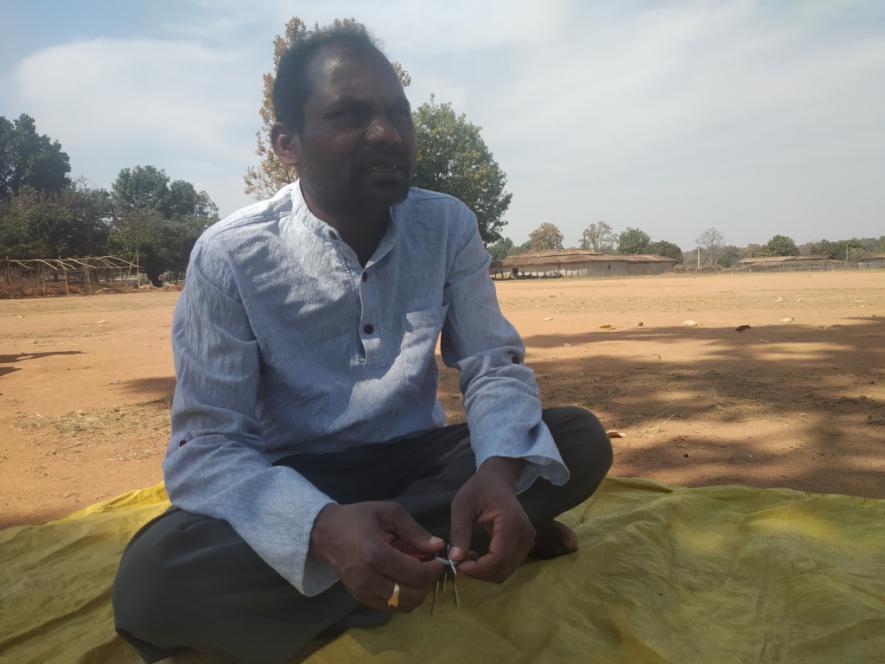
Jayanandan Singh Porte, co-convenor of the Committee for the Struggle to Save the Hasdeo Forest. Photo Abir Dasgupta
Under Indian law, the Forest Rights Act, which enables people to claim rights to forest land and resources, should apply to the Hasdeo forest. Claims have to be validated by the government, and, once recognised, are a legal protection against land acquisition for industrial projects. Under the previous government, one such claim had been recognised and then dismissed. In the run-up to the 2018 state election, Congress had said it would take up the claims, but since coming to power, it has dithered. ‘We have to see whether the Forest Rights Act or the Coal Bearing Areas Act applies; the two are contradictory,’ the Chief Minister Baghel told NewsClick.
So, Porte says, ‘we started a protest campaign in 2019.’ When I spoke with HABSS members in November 2019, they were in the thick of that campaign, then a month old. The protest site was a school ground in Fatehpur village. Now, it is at the same school ground where I am meeting him. The frame and stage of the protest site are still intact at one corner of the ground. Mats are brought over from under the stage for my interview with residents of Fatehpur.
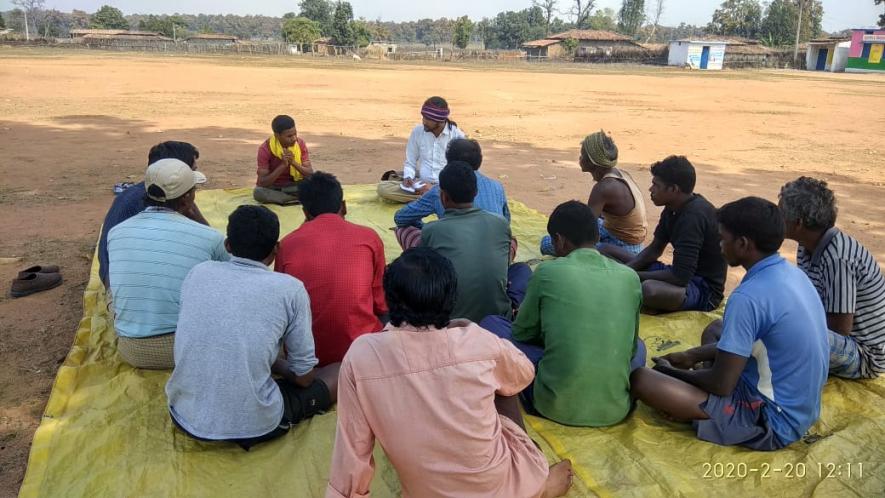
Meeting in the village of Fatehpur. Photo Abir Dasgupta
How Adani’s Entry Has Affected the Region
As I speak to Porte, a group of nearly 40 residents of Fatehpur joined us at the school ground. Some of them open up on how life had changed under the shadow of the coal mine. ‘We are a self-sufficient community,’ says Ramnath Shyam, 60. ‘We barely have any needs that the forest doesn’t fulfil. There are times when we only have to go to the market for salt.’
Now, as coal mining alters the landscape, self-sufficiency is becoming threatened. The coal mine threatens the Salhi River, a stream that feeds the Hasdeo River. Earlier it was at least 40 feet wide and a source of fish for the community, both for their own consumption and for sale. Now, residents say the water in the stream frequently turns black, due to – they allege – the PEKB mine’s coal washery dumping its runoff into it. 'Initially this was a persistent problem,' says Bal Sai Korram, 49, an elected representative of Hariharpur village, that is virtually adjacent to the mine. 'The water would turn black every other day.' This was one of several issues on which the HABSS campaigned in its earlier years. 'We were able to put enough pressure on the company for this to stop,' continues Korram. In recent months, however, he says the practice has begun once again, albeit, less frequently.
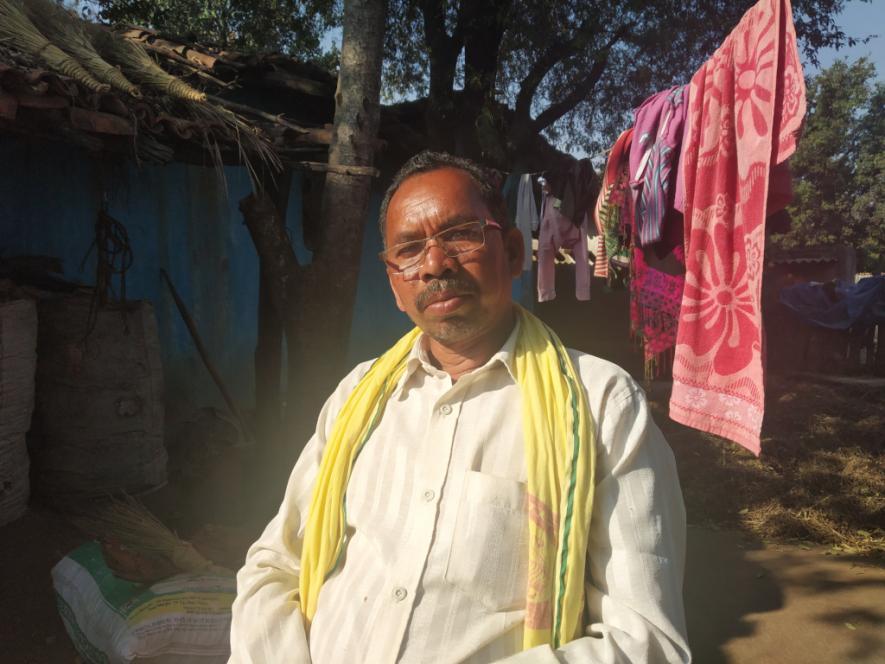
Bal Sai Korram, an elected representative of Hariharpur village. Photo Abir Dasgupta
Adani denied that its operations had affected watercourses in the area. ‘The washery at the PEKB coal mine in India, which is owned by the state utility Rajasthan Rajya Urja Vlkas Nigam Limited, works on a ‘zero discharge’ principle,’ said an Adani spokesperson. ‘All water generated through washing is recycled through a system of belt presses and then reused. None of this water is discharged from the mining area into nearby water courses as it is all recycled.'
Another problem, Korram adds, were frequent road accidents that threatened the lives of people and wildlife alike during the first two years of the mine’s operation. Low grade ‘spillage’ coal that is sold by Adani to industries in the state’s capital – Raipur – used to be transported on large trucks, as the rail link was yet to be completed. 'Hundreds of our (Adivasi) people were killed in accidents involving the trucks transporting coal. We appealed to the state government to ban the movement of these trucks and it was stopped.' Recently, he says, activists from Raipur have alerted him that Adani has applied for permission to start transporting the coal by road once again. 'We have been told that the company says it is financially beneficial to the state of Chhattisgarh if it is allowed to run its trucks. If it starts, we will campaign against it again,' he concludes.
While admitting the difficulties caused by such disruptions, my informants are not overwhelmed by them. Ram Bhola Yadav, 40, says ‘we are still able to survive, the issue is not that. The problem is the social changes that Adani is bringing here.’
Adivasis are not Hindus according to any scriptural definition or religious practice. They are animists who worship an array of local, nature-centric deities, though this is not recognised by India’s official classifications of religion.
‘The forest is our God,’ Yadav continues. ‘Our festivals and beliefs are all tied to nature.’
Adani is seeking to ‘Hinduise’ them, the villagers say. Two years ago, for the first time ever, the Hindu festival of Ganesh Puja (worshipping the Elephant God) was celebrated in Hasdeo. Adani financed bombastic celebrations in every village, says Samaylal Markam, 30.
‘It can be seen as a kind of social engineering,’ says Alok Shukla, the convenor of Chhattisgarh Bachao Andolan (Campaign to Save Chhattisgarh), with destruction of Adivasi life from both ends. ‘Their land, forest and livelihood are destroyed by coal mining and displacement, and their distinct culture and tradition are appropriated and replaced with commercial mainstream Hinduism, and they are slowly assimilated.”
It is an issue that connects at a national level. At the same time as I am having these conversations, a protest is going on in New Delhi, organised by a national collective of Adivasi organisations demanding that India recognise Adivasi religion as distinct from Hinduism and specify it as an additional religious category for India’s next decennial census, in 2021. Ramlal Kariyam, 29, an elected representative of Salhi, another village adjacent to the PEKB mine, and one of HABSS’s key activists, plays a video of the protest for the group on his mobile phone.
As we speak, a muffled sound of an explosion momentarily fills the air. It is coming from the PEKB mine, less than a kilometre away. HABSS keeps track of the blasts’ frequency. On average there are nine or ten of them a day. Over the next 15 minutes, we hear three more blasts.
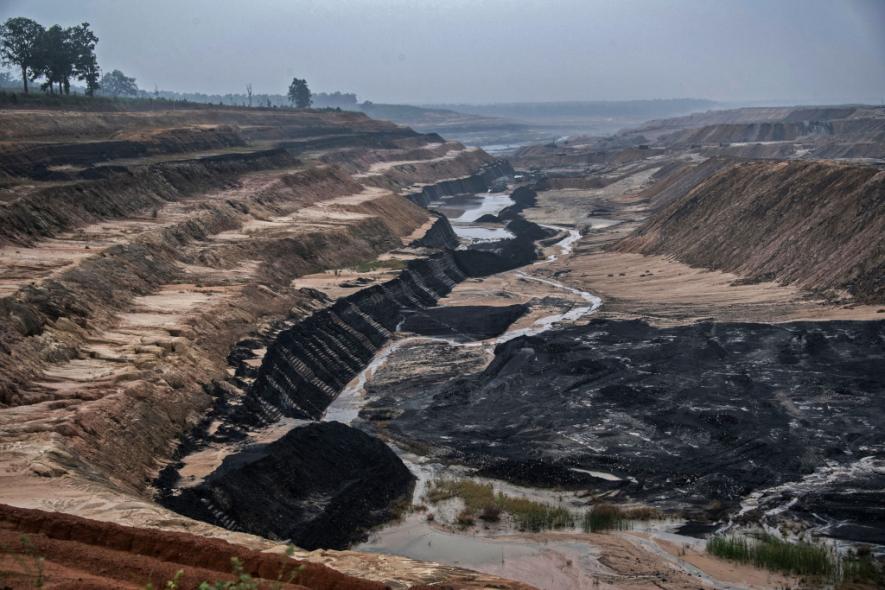
The PEKB mine, operated by Adani. Photo Brian Cassey www.briancasseyphotographer.com
There is another way in which the company is affecting the local community. It has built a school and a skill-development centre side by side in Salhi, a nearby village. The school – Adani Vidya Mandir Salhi – was given an ‘Empowering India Award’ by India’s central government earlier in the month. Receiving the award, Gautam Adani’s wife, Priti, who heads the Adani Foundation, said ‘Adani Vidya Mandir is preparing children from the underprivileged sections of society to navigate their future with confidence.’
‘No Adivasis from Hasdeo are allowed admission into the school or the skill-development centre,’ Kariyam tells me. They cater to the families of landlords outside the forest region, he claims. He has been lobbying to try to get the school and the centre to reserve a certain proportion of admissions for Adivasis, to little avail. On one occasion, he was manhandled by security guards when he sought to enter the complex to attempt to meet the school’s principal.
Adani disputes these accounts of its conduct in the local area, categorically rejecting allegations of cultural exclusion. ‘Our ethos is based on providing equal opportunities to all – regardless of caste, creed, colour, or religion and we are proud of being a secular and nonpartisan entity,’ an Adani spokesperson said.
‘The Adani Foundation’s mission is to play the role of facilitator for the benefit of people without distinction of caste or community, sector, religion, class or creed across education, community health, and the promotion of social and economic welfare. All our not-for-profit schools and skill development centres are also governed by the same philosophy.
Shortly after my meeting with the villagers in Fatehpur, we drive past the school complex. It is a state-of-the-art facility that couldn’t be more out of place on this unpaved road. As we slow down to take photographs, uniformed security guards approach the vehicle, but we drive off before they can confront us.
We have no such luck at the PEKB mine itself, however. We drive down a dirt road that winds around behind the mine and stop to take photographs. A uniformed security guard sprints up to us. There is no photography allowed here, he says, we must delete our photos.
‘We can’t take photos of our own homes? This mine is built on our land,’ counter the two residents of Hariharpur who are guiding us. A back and forth ensues; we ask for a written copy of the order that supposedly denies us the right to take photos; the guard suggests we accompany him to the site manager. Eventually he relents and we are able to pass unmolested. Such encounters between staffers at the mine and locals are frequent, we are told, and they are not always resolved as easily.
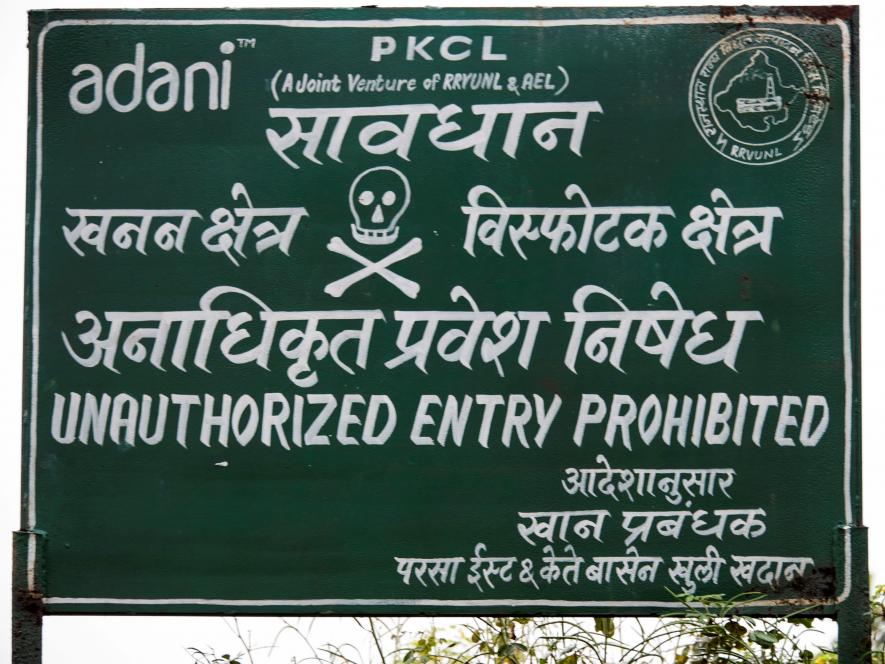
Adani danger sign near the PEKB mine. Photo Brian Casseywww.briancasseyphotographer.com
A new campaign tactic makes the Hasdeo struggle unique
In January 2020 the Adivasi protest was suspended voluntarily by the HABSS as it had settled on a new tactic. Its members would stand for the panchayat election and seek legislative and executive power at the grass-roots level of Indian democracy. (A gram panchayat is a village council, an elected body.) ‘Most of our candidates won, but we did lose a few critical seats,’ Porte says. He was one of the winning candidates and is now the head of local government of his village of Fatehpur.
‘The company tried many ways to subvert our election campaign. They committed a lot of money to the election. In one case, a man supporting the company claimed to be associated with our organisation and won a seat,’ he continues. Numerous water pumps and sewing machines were distributed and installed by Adani, he says. Most of the candidates who stood against HABSS were identified by the Adivasi community as company dalaals or agents; they were on the Congress party’s ticket.
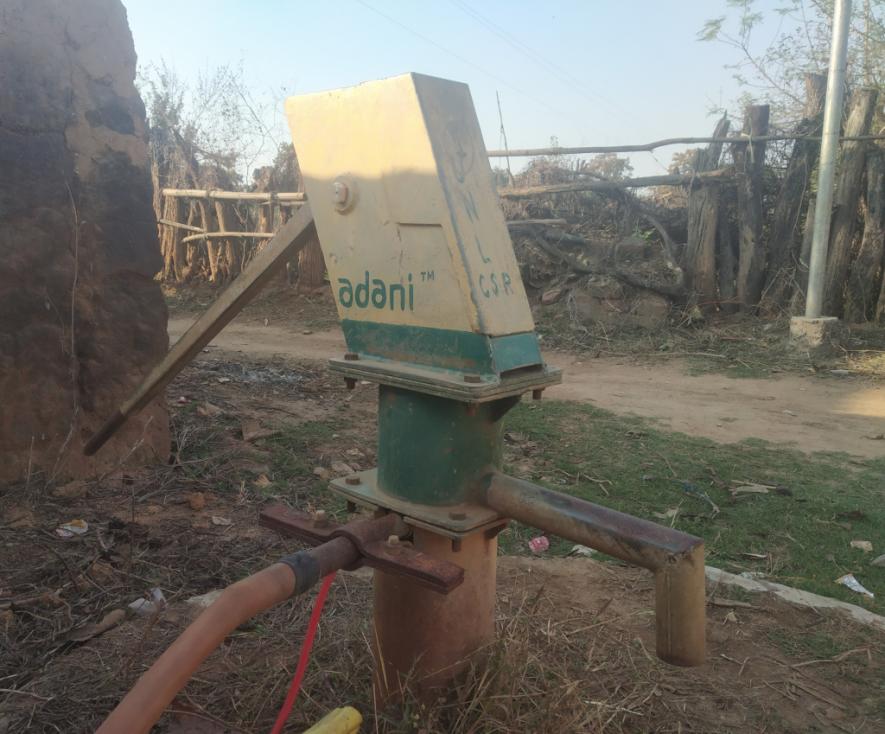
Adani-branded water pump at a local home. Photo Abir Dasgupta
Despite these efforts, HABSS now has a stronghold on the levers of local government in the coal-mining belt of the Hasdeo Aranya forest. This has transformed a civilian political movement into a force that has won executive power, albeit at the local level. Shukla believes this makes the struggle to prevent coal mining in Hasdeo a unique one in India’s varied history of such struggles.
‘It is now a fight between the panchayats and the higher levels of government; this gives us a lot of advantages we didn’t have earlier,’ he says.
Porte and Shukla both confirmed, separately, that a strategic option that was increasingly gaining popularity among locals was outlawing the entry of Adani officials into villages across the region without permission from the local authorities.
Securing Adivasi rights to the forest
The conflict that is playing out in the Hasdeo forest between the corporate coal-mining industry and the indigenous Adivasi community is one that has many replicas across India. It is a conflict that started even before the establishment of the modern Indian state, when India was ruled by the British East India company in the 18th and 19th centuries. The central and eastern parts of the Indian subcontinent are some of the most resource-rich parts of the country and the richest in biodiversity. They are also home to millions of Adivasis.
In recent decades, as such struggles have grown and supportive networks developed, a consensus was developed over the rights of the Adivasi communities to the forests around which their lives and livelihoods are centred. This was formalised in an Act of Parliament passed in 2006 that is called The Scheduled Tribes and Other Forest Dwellers (Recognition of Forest Rights) Act, or simply, the Forest Rights Act.
Under this act, Adivasis (known as Scheduled Tribes in India’s official parlance) and other forest residents can claim three categories of rights to any forest area – Individual Forest Rights (IFRs), Community Forest Rights (CFRs) and Community Resource Rights (CRRs). Community claims can be made only by local governments or panchayats. These claims have to be examined and approved by the district administration that represents the state government, and, if they are approved, the land becomes inaccessible for acquisition for the purpose of mining or any other industrial activity. This is why the victories of HABSS in the panchayats assume a great significance.
Shukla explains: ‘Until now, only a few IFR claims have been granted, and no CFRs or CRRs have been considered. In only one case has a CFR application by a panchayat been approved, but later the district collector unilaterally cancelled it.’
This is the case of Ghatbarra, a village that lies within the area threatened by the proposed new Parsa coal mine. In a move analogous to the unilateral cancellation of the native title to indigenous Wangan and Jangalingou land in favour of Adani’s Carmichael coal mine in Australia, a successful CFR claim that had been made by the Ghatbarra panchayat in 2013 was unilaterally cancelled in 2016. The claims made by the other villages in the Parsa block, including Salhi, Fatehpur and Hariharpur, remain before the district administration, yet to be processed after more than seven years.
‘The Congress promised to immediately take up the issue of claims under the Forest Rights Act if they came to power in Chattisgarh,’ Shukla explains. ‘It has been nearly a year and a half, and they have not done anything yet.’
Securing their claims under the Forest Rights Act represents the strongest route to victory for the campaigners trying to save the Hasdeo forest. It appears, however, that since coming to power, the Congress is unsure of fulfilling its promise. In his interview with Newsclick, Chief Minister Bhupesh Baghel was asked ‘In the Hasdeo Aranya region, the people have demanded that the terms of the Forest Rights Act must apply, and their rights respected. Will you listen to them?’
‘Of course we will listen to them,’ the Chief Minister replied. ‘In the Hasdeo matter, we have to see whether the Coal Bearing Areas Act will apply or the Forest Rights Act will apply. The two acts are contradictory. It is important to see which act’s terms will apply.’
The Chief Minister’s equivocal response is ominous. The outcome will be determined by the battle between the indigenous people at a local level and a state government inordinately influenced by the clout of the Adani Group’s coal-mining corporations. But the local people have an ace up their sleeve.
‘Since we are holding the panchayats, we will be able to take up the claims more forcefully now,’ said Porte with determination. ‘If we can prevent the next mine from opening, we can protect all of the rest of the forest.’
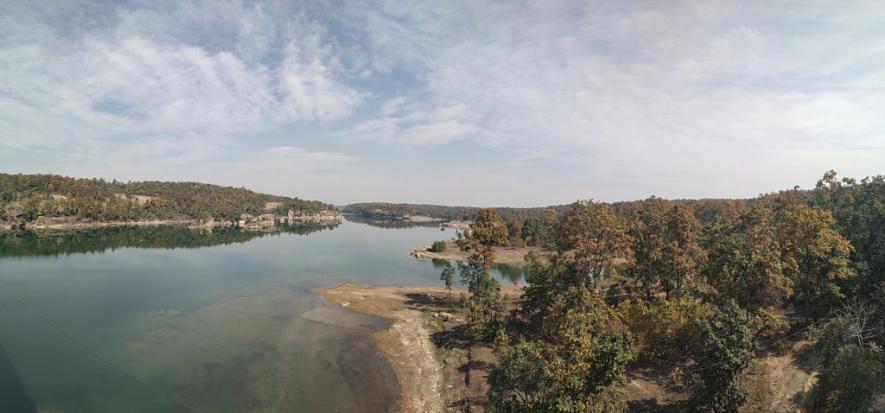
The Hasdeo River and adjacent forests. Photo Abir Dasgupta
Get the latest reports & analysis with people's perspective on Protests, movements & deep analytical videos, discussions of the current affairs in your Telegram app. Subscribe to NewsClick's Telegram channel & get Real-Time updates on stories, as they get published on our website.
























